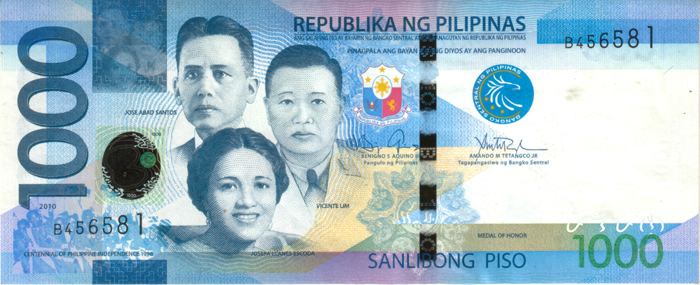The Philippine one thousand-peso note (Filipino: Sanlibong Piso) (₱1000) is a denomination of Philippine currency. José Abad Santos, Vicente Lim, and Josefa Llanes Escoda are currently featured on the front side of the bill, while the Tubbataha Reefs Natural Park and the South Sea pearl are featured on the back side of the bill.
1944: Japanese government issued series, Due to hyperinflation caused by the ongoing World War II, the Japanese was forced to issue higher denominations of their fiat peso. The banknotes ceased on becoming legal tender after the liberation.
1991: New Design series, The Central Bank of the Philippines introduced the one thousand peso denomination December 1991. The bill features the portraits of former Chief Justice José Abad Santos; Josefa Llanes Escoda, civic worker and one of the founders of the Girl Scouts of the Philippines; and Vicente Lim, a general in the Philippine Army who was the first Filipino graduate of West Point. The three are considered heroes of the resistance against the Japanese occupation of the Philippines. The obverse also features the eternal flame and laurel leaves. The bill is predominantly blue in color. The reverse features the Banaue Rice Terraces, Manunggul Jar cover and Langgal, representing the three islands of the Philippines (Luzon, Visayas, and Mindanao, respectively). This is also the only bill on the series that features the Optically Variable Ink, which was used on the "1000" on the lower left side of the obverse.
1993: After the creation of the "Bangko Sentral ng Pilipinas", its new logo was incorporated on all the New Design series bills.
1998: The year of printing was added at the bottom of the denomination value located at the upper left corner of the obverse.
1999: The signature of the Philippine president was moved slightly to the left to accommodate the names of the signatories on the bills and added them starting with banknotes featuring the signature of President Joseph Estrada.
2001: Additional security features were added; the Optically Variable Ink used in the "1000" on the lower left side was enhanced. Other features that were added are the security thread on the right side and the fluorescent printing on the left side across the portrait. Also, the signatures of President Gloria Macapagal-Arroyo and BSP governor Rafael Buenaventura were introduced earlier than the features mentioned above which makes the only banknote with the 2001 year mark to not feature the signature of President Joseph Estrada.
2010: New generation series, The portraits of Abad Santos, Escoda, and Lim were revised, and a scene from the Centennial celebration of Philippine independence was added on the lower left. The reverse now features the Tubbataha Reefs Natural Park and the South Sea pearl.
Throughout its existence, the one thousand peso bill have been overprinted to commemorate certain events, namely:
On July 9, 2009, the Bangko Sentral ng Pilipinas introduced 12 million banknotes (2 million banknotes for each denomination) with an overprint commemorating 60 years of central banking. The overprint appears on the watermark area on all six circulating denominations.

